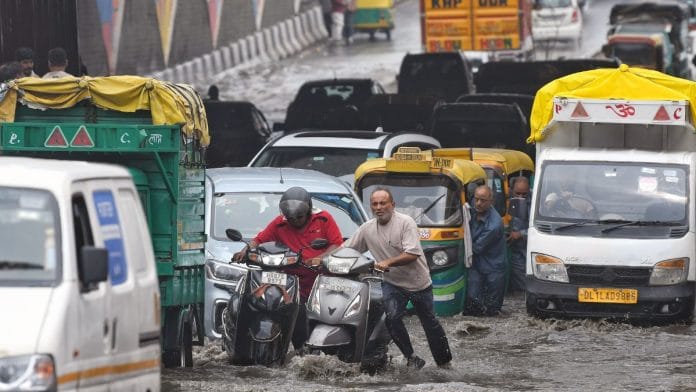Thank you dear subscribers, we are overwhelmed with your response.
Your Turn is a unique section from ThePrint featuring points of view from its subscribers. If you are a subscriber, have a point of view, please send it to us. If not, do subscribe here: https://englishdev.theprint.in/subscribe/
During the night of 27/28th June 2024 many Delhiites lost their homes and belongings. These very people were dying of heat strokes just a while earlier when temperatures had gone as high as 52.9C, they were confused, agitated, sick in their stomachs and had flushed skin. The streets had become deserted, shops had started shutting down during mid days. On the other hand, the so-called privileged section of society had their many air conditioners cooling them while throwing the hot air in already hot surroundings. During the night of 27/28th June when the roof of the airport had collapsed, there were flight disruptions, closure of metro stations, extensive traffic congestion due to water-logged streets and flooded underpasses and many Delhiites spent hours collecting their belongings floating on accumulated water the so-called privileged section was enjoying first big rain and onset of picnic time.
Delhi exposed
One night’s 228 mm of rain fall exposed Delhi, revealed the failures of its political leaders, scientists, technocrats and people of Delhi.
Political leaders failed to lead the way to total revamping of water ways and management as left by Britishers. Scientists failed to come up with a model water management system for Delhi. Technocrats failed to create infrastructure needed to eliminate or reduce the water woes. The self-centered, arrogant Delhiites failed to cooperate and take simple needed steps.
Reasons
The three main reasons behind Delhi being a water starved city are: concrete in its forest areas, centralized sewage treatment system and non-percolation of rainwater in the ground.
Way out
Delhi can still be saved from becoming a water negative city if political leaders, scientists, technocrats and Delhiites come out of their bubbles, think and work collectively. Government must De Concretize forests, De-Centralized sewage system and introduce Swales along the sides of its roads and by lanes. Delhiites must stop wastage of water and create volunteers to monitor water use and abuse.
Measures by the Government
- Zero Concrete in forests
Delhi’s natural forest – The Ridge at present has only one or two rows of trees along the roads so it looks green but beyond that concretization has reduced its water percolation area.
If all concrete is cleared from the Ridge, it is greened and declared a ‘zero concrete area’ it would certainly affect the underground water table of the city. All rain falling on The Ridge will percolate, with no runoff saving the roads and colonies adjacent from waterlogging. As I covered The Ridge on June 28, 2024, here I am only mentioning Ridge’s role in making Delhi water sufficient.
2. Creating lagoons
Creating water lagoons in middle-income colonies would increase its water percolation area and create habitat for aquatic life. In a low-income colony introducing water hysynth in the lagoons, sand and gravel beds and anaerobic digestion chamber would not introduce decentralized sewage system but also provide free biogas and additional income from the manure from sludge.
This one step would decrease pollution load on Yamuna, increase water percolation area of the city and raise underground water table.
3. Introducing Swales
Swales are green structures that help raise the water table. Through them rain water percolates under the ground instead of going to sewers or accumulating on the roads, lanes, by lanes and streets etc. They are big shallow troughs covered with bar window grills, porous bottoms and slanting flaps to be greened.
Swales cost fifty percent less than installing rainwater sewers and are fifty percent more efficient in infiltrating rainwater in the ground. I have seen them work wonderfully in many parts of the world.
Measures by civic society
Stop water wastage by
1.Keeping rain water drains clear .
2.Rectifying faulty water management system.
3 Reusing and recycling of water.
- Insulating water pipes.
- installing water efficient pumping fixtures like low flow faucets and low flow shower heads etc.
- Directing rooftop water to filters to pipes and then to a storage tank.
7.Stopping washing of cars, floors, stairs etc with buckets full of water.
- shortening shower time.
9 creating a voluntary force to identify the reasons for water wastage in your area and stopping it.
- Identifying water misuse in your area and rectifying it.
- The treated municipal wastewater and industrial wastewater is used to irrigate, fight fires and reused in industries but its use for toilet flushing is still rare. All Delhiites must make provisions of using treated grey water for flushing. Get dual pipes installed for drinking water and reclaimed water.
Last words
Water management is one of the essential activities both at the government and individual level. The easiest part of water management is to stop further depletion of ground water. Work must be done to raise underground water table, reusing, conserving, reducing consumption, recycling ground water and incorporating as many alternative water sources as possible.
These pieces are being published as they have been received – they have not been edited/fact-checked by ThePrint


